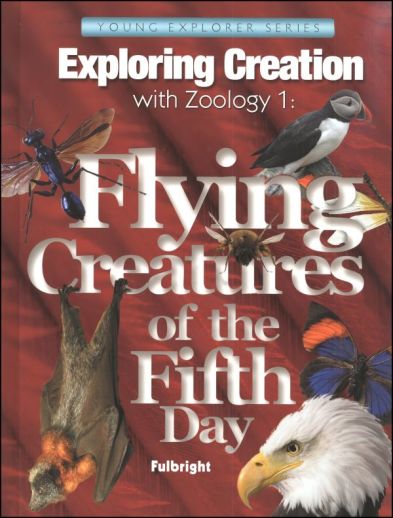We use cookies to make your experience better. To comply with the new e-Privacy directive, we need to ask for your consent to set the cookies. Learn more.
Exploring Creation with Zoology 1: Flying Creatures of the Fifth Day
Birds, bugs, and bats if it flies, it's explored in this fascinating introduction to zoology! The first portion of the book focuses on birds and their unique characteristics. Kids will learn bird anatomy, how they are able to fly, why they build nests, how they raise their young, and more. They'll also learn to identify the birds they see every day and do activities that explore the habits and preferences of different species of birds. Students will learn about bats, some of the most useful and wonderful flying creatures in the world. As they study the physical characteristics and lifestyle of the bat, they'll gain a new appreciation for these creatures. Finally, kids will get up close and personal to the insect world. They'll learn how to identify and classify the many different types of bugs they see, and they'll even get to design their own experiments with different insect species. Kids will get the opportunity to keep their own field journals as they are encouraged to be their own scientist as they observe and understand the world around them.
In this book, your children will begin exploring the dynamics of flight and animal classification, understanding why the design we see in these incredible creatures points us to our Creator God. Then, get ready for the exciting adventure of learning about birds. Your children will learn how to attract various bird species to your yard and identify them by looking at their special physical characteristics, diverse nests, and interesting domestic practices. They will also learn the anatomy and the glorious design that enables birds to do remarkable things. The text contains actual experiments on the preferences and habits of the birds your children see. These experiments further enrich the learning experience.
After becoming amateur ornithologists, your children will explore the world of chiropterology, which is the study of bats. They will be able to intelligently share with others the value of bats in our world while exposing the misconceptions that most people have regarding these docile creatures of the night. Your children will then investigate entomology, the study of insects. They will learn to scientifically classify insects they find in their yard by a simple glance at their wings and other important characteristics. In addition to designing experiments with flies, crickets, darkling moths, and caterpillars, they will also learn how to attract and catch insects for scientific study.
When your children complete this study of zoology, they will never view nature in the same way again. Their eyes will be open to the different species that live in their midst, enjoying and understanding nature to the fullest. Vacations will become educational experiences as they notice birds and insects inhabiting the areas they visit. By learning to keep a field journal, they will be able to notice unusual circumstances or sudden increases in bird or insect populations. They will become true scientists as they come to know nature and the fascinating world that God created.
Birds, bugs, and bats if it flies, it's explored in this fascinating introduction to zoology! The first portion of the book focuses on birds and their unique characteristics. Kids will learn bird anatomy, how they are able to fly, why they build nests, how they raise their young, and more. They'll also learn to identify the birds they see every day and do activities that explore the habits and preferences of different species of birds. Students will learn about bats, some of the most useful and wonderful flying creatures in the world. As they study the physical characteristics and lifestyle of the bat, they'll gain a new appreciation for these creatures. Finally, kids will get up close and personal to the insect world. They'll learn how to identify and classify the many different types of bugs they see, and they'll even get to design their own experiments with different insect species. Kids will get the opportunity to keep their own field journals as they are encouraged to be their own scientist as they observe and understand the world around them.
| Product Format: | Softcover Book |
|---|---|
| Grades: | K-6 |
| Brand: | Apologia |
| ISBN: | 9781932012613 |
| Length in Inches: | 11.25 |
| Width in Inches: | 8.75 |
| Height in Inches: | 0.75 |
| Weight in Pounds: | 2.1 |
The textbook is hardback but the nature journals are spiral bound.
It seems set up for a one semester course. It goes along with the seasons. In our case, we have used it for 2 years. There is a lot to complete and with other subjects we stretched it out for 2 years.
2.45#
The publisher encourages starting the Zoology sequence with Exploring Creation with Zoology 1. However, it is possible to start with Zoology 3 if you take the time to complete Module 1 of Zoology 1 first. That Module is available as a download from our website - "download a sample" button under the add to cart/add to wishlist box. - http://www.rainbowresource.com/proddtl.php?id=010470


using at co-op
Ive used this before and it is a magnificent science curriculum. The way it is presented keeps younger children’s interest and gives them a love for science.
It came highly recommended.
My daughter's hybrid homeschool program required it.